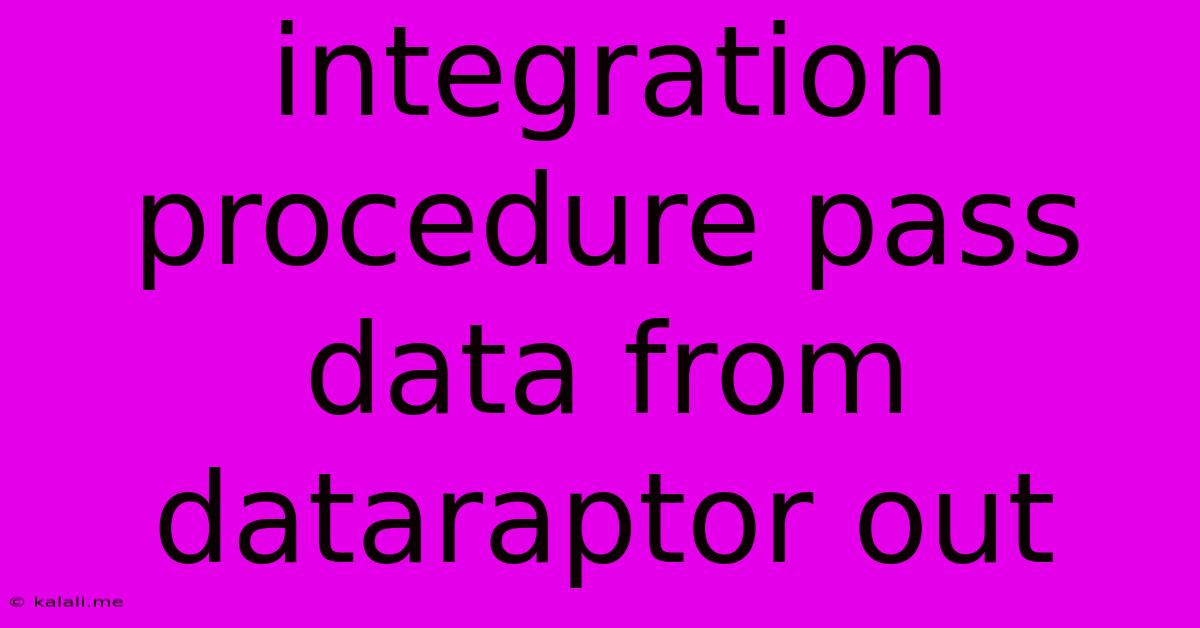Integration Procedure Pass Data From Dataraptor Out
Kalali
Jun 08, 2025 · 3 min read

Table of Contents
Integrating DataRaptor: A Smooth Data Transfer Process
DataRaptor, a powerful data integration tool, simplifies the process of pulling data from various sources and transforming it into a usable format. This article details the procedure for seamlessly integrating DataRaptor and passing data out, focusing on efficient methods and best practices. Understanding these steps is key to leveraging DataRaptor's capabilities for your data workflows.
What is DataRaptor? (Keyword: DataRaptor integration)
DataRaptor is a no-code/low-code ETL (Extract, Transform, Load) tool enabling users to connect to diverse data sources, clean, transform, and prepare data for analysis or application use. Its strength lies in its intuitive interface and powerful capabilities, making complex data integration tasks relatively straightforward. The ability to effortlessly pass data out of DataRaptor is crucial for its effectiveness.
Steps to Integrate and Pass Data from DataRaptor
The exact integration procedure varies based on your destination system, but the general steps remain consistent. Here’s a breakdown of the process:
1. Connecting to Your Data Source
This initial step involves establishing a connection to your source data. DataRaptor supports a broad range of connectors, including databases (SQL Server, MySQL, PostgreSQL, etc.), cloud storage (AWS S3, Google Cloud Storage, etc.), APIs, and spreadsheets. You will need the necessary credentials (database connection strings, API keys, etc.) to complete this step successfully. Ensure your credentials are secure and stored appropriately. (Keyword: Data Source Connection)
2. Data Extraction and Transformation
Once connected, you'll specify the data you wish to extract. This might involve selecting specific tables, columns, or applying filters to narrow down your dataset. DataRaptor allows extensive data transformation capabilities, including:
- Data Cleaning: Handling missing values, removing duplicates, and correcting inconsistencies.
- Data Transformation: Changing data types, calculating new fields, and reformatting data.
- Data Enrichment: Adding data from other sources to enhance your dataset. (Keyword: Data Transformation)
This is a crucial stage to ensure data quality and relevance before passing it to your destination.
3. Choosing Your Output Method
DataRaptor offers various methods for exporting your transformed data:
- Direct Database Integration: If your destination is a database, DataRaptor can directly load the data into specified tables.
- File Export: Data can be exported to various file formats like CSV, JSON, XML, or Parquet for later use in other systems.
- API Integration: Data can be passed to external systems via API calls, offering real-time data integration. (Keyword: Data Export Methods)
- Cloud Storage Integration: Export data directly to cloud storage services like AWS S3 or Google Cloud Storage.
The optimal choice depends on your specific needs and the capabilities of your destination system.
4. Setting up the Output Destination
Depending on the chosen output method, you will need to configure the destination. This might involve specifying:
- Database credentials: For direct database integration.
- File path: For file exports.
- API endpoint and authentication: For API integrations.
- Cloud storage bucket and credentials: For cloud storage integration. (Keyword: Output Destination Configuration)
Ensure the specified credentials and settings are correct to avoid errors.
5. Running the DataRaptor Workflow and Monitoring
Once all the settings are configured, execute the DataRaptor workflow. Monitor the process to ensure it runs successfully. DataRaptor typically provides logs and status updates to assist in troubleshooting any issues.
6. Testing and Validation
After successfully running the workflow, thoroughly test the data in your destination system to ensure the data has been accurately transferred and transformed. Validate the data integrity and consistency.
Best Practices for DataRaptor Integration
- Modular Design: Break down complex integrations into smaller, manageable workflows.
- Error Handling: Implement robust error handling mechanisms to catch and address potential issues.
- Version Control: Track changes to your DataRaptor workflows for auditing and reproducibility.
- Security: Securely manage your credentials and access controls. (Keyword: DataRaptor Best Practices)
By following these steps and best practices, you can effectively integrate DataRaptor into your data workflow and seamlessly pass data out to various destinations. Remember to choose the appropriate output method based on your specific requirements and always validate your data after transfer.
Latest Posts
Latest Posts
-
Meaning Of See You On The Flip Side
Jun 09, 2025
-
Find The Region Common To Both Circles Area
Jun 09, 2025
-
What Is Expression Of Interest Job Mean
Jun 09, 2025
-
How To Feed 2 Month Old Pigeons Food
Jun 09, 2025
-
Pros And Cons Of Whole House Humidifier
Jun 09, 2025
Related Post
Thank you for visiting our website which covers about Integration Procedure Pass Data From Dataraptor Out . We hope the information provided has been useful to you. Feel free to contact us if you have any questions or need further assistance. See you next time and don't miss to bookmark.